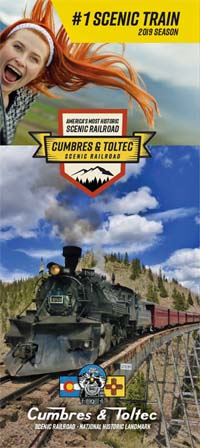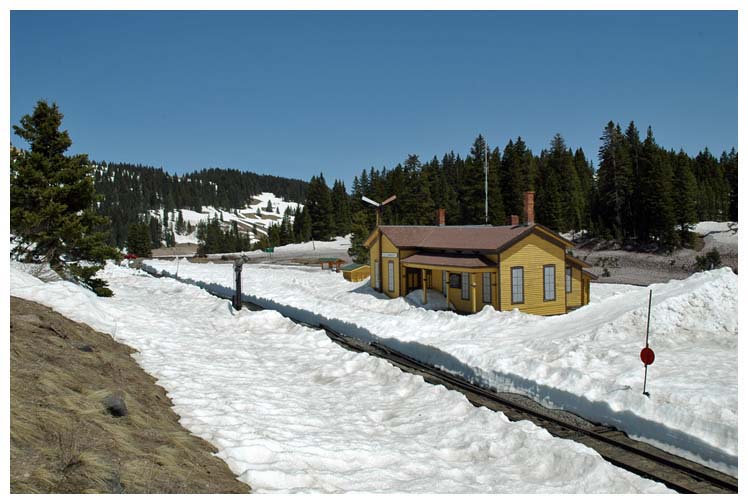
Cumbres & Toltec Scenic Railroad
Chama New Mexico USA
N36.902477 W106.580423

 The state of Colorado was once covered by a circle of three foot narrow gauge railroads as shown on this map below. (Note: This map was stolen from the Narrow Gauge Circle web site which contains a tremendous wealth of information on Colorado narrow gauge railroads.)
The state of Colorado was once covered by a circle of three foot narrow gauge railroads as shown on this map below. (Note: This map was stolen from the Narrow Gauge Circle web site which contains a tremendous wealth of information on Colorado narrow gauge railroads.)
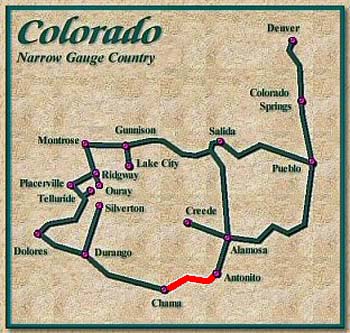
The lines on the map, which comprise several railroads, are now abandoned or completely obliterated. Except... two sections have been saved for posterity. One, the Durango & Silverton Narrow Gauge Railroad, which operates between Durango and Silverton, and two, the area shown in red, which is the subject of this article. This blue section of track is now known as the Cumbres & Toltec Scenic Railroad (C&TS). It connects Chama, New Mexico, and Antonito, Colorado.
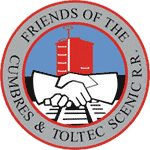 This story really began in 1871 with the construction of the Denver & Rio Grande Railroad. Starting from Denver, Colorado, this railway was aimed towards Mexico City, Mexico, but it never made it. By 1876 the silver mines of southwestern Colorado diverted its direction. The San Juan Extension was built west from Antonito beginning in 1880. This three foot gauge line cris-crossed the Colorado-New Mexico border to reach Chama, then on to Durango and Silverton where the mines were located. When the silver boom failed in 1893, the railroad survived on coal, lumber, and merchandise traffic. Then an oil boom at Farmington, New Mexico, in 1950 created heavy traffic in drilling equipment. By 1960 this boom also died. The last revenue train ran in 1968. In 1970 the states of Colorado and New Mexico purchased the section between Chama and Antonito. Except for the Durango-Silverton route, now landlocked, all else was abandoned. Several companies ran the C&TS for the state's Commission until the "Friends of the Cumbres & Toltec Scenic Railroad", a non-profit organization, formed the Rio Grande Railway Preservation Corporation to operate the railroad. 2001 marked their second season running the railroad. The photos included with this article were taken between 2001 and 2008.
This story really began in 1871 with the construction of the Denver & Rio Grande Railroad. Starting from Denver, Colorado, this railway was aimed towards Mexico City, Mexico, but it never made it. By 1876 the silver mines of southwestern Colorado diverted its direction. The San Juan Extension was built west from Antonito beginning in 1880. This three foot gauge line cris-crossed the Colorado-New Mexico border to reach Chama, then on to Durango and Silverton where the mines were located. When the silver boom failed in 1893, the railroad survived on coal, lumber, and merchandise traffic. Then an oil boom at Farmington, New Mexico, in 1950 created heavy traffic in drilling equipment. By 1960 this boom also died. The last revenue train ran in 1968. In 1970 the states of Colorado and New Mexico purchased the section between Chama and Antonito. Except for the Durango-Silverton route, now landlocked, all else was abandoned. Several companies ran the C&TS for the state's Commission until the "Friends of the Cumbres & Toltec Scenic Railroad", a non-profit organization, formed the Rio Grande Railway Preservation Corporation to operate the railroad. 2001 marked their second season running the railroad. The photos included with this article were taken between 2001 and 2008.
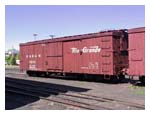


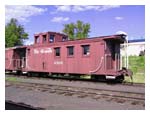


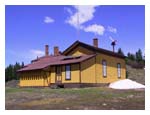
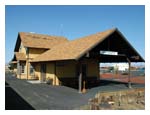
The railroad offers several options for riding their line. In fact, there are so many options they may be confusing. You can ride:
- Chama to Osier and return
- Antonito to Osier and return
- Chama to Antonito returning by bus
- Antonito to Chama returning by bus
- Chama to Antonito by bus returning by rail
- Antonito to Chama by bus returning by rail
If you're confused, consult the latest options on the C&TS web site linked at the end of this article.
During the operating season, a train departs eastbound each morning from Chama, and westbound from Antonito. They both meet at Osier where a large building containing a lunchroom and gift shop is located. For me, it was an easy decision. Here's why I chose to ride from Chama to Osier and return, each way by rail:
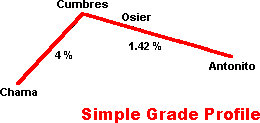
As you can see, the grade between Chama and Cumbres is 4 percent. They use double-headed steam locomotives to climb this hill... decision made!
Two locomotives depart Chama eastbound until reaching Lobato Trestle. This iron bridge, constructed in 1881, is too frail to support a pounding by two locos together. The lead engine is cut-off and proceeds across alone with the second engine bringing the train across. Once re-coupled they WORK up the four percent grade to the summit of Cumbres Pass at an elevation of 10,015 feet. Here the lead locomotive, the helper, is removed from the train. It waits at Cumbres as protection while the second loco continues with the train to Osier. Upon reaching Osier the helper is free to return to Chama. Lunch is served to the passengers at Osier upon arrival. About 45 minutes later the train from Antonito also arrives for lunch. First in, first out, the trains return to their respective originating stations. I opted to photograph the arrival of the second train and nearly missed lunch.
Somewhere I heard, or read, when riding the Durango & Silverton you spend your time looking up. On the Cumbres & Toltec, you look down. I don't know about the rest of the line, but between Chama and Osier this is certainly true. Starting in Chama, at an elevation of 7,863 feet, the route crosses the wide valley of the Rio Chama River a short distance before commencing the long 4 percent climb to the summit at Cumbres. During this climb the vista includes sweeping views of the rolling mountains and valleys dotted with evergreen fir trees interspersed with deciduous Aspen trees. In May, the Aspens are a light green colour with fresh leaves. By fall they turn a golden yellow. Highway 17 generally parallels the route between Chama and Los Pinos Tank offering easy access to most of the line. East of Los Pinos Tank, the highway diverges from the railroad to the north by several miles, then continues east paralleling the rail route. After Los Pinos I didn't explore any access roads south towards the railroad, there may or may not, be some.
Because of the steep grade up to Cumbres, double-headed trains climb slowly giving ample time to photograph them and drive ahead of the train for more shots. In May, on the first day of the season, the train was followed by a caravan of cars and photographers who get carried away in the excitement. Save yourself some agony, drive the route beforehand looking for photo spots and position yourself before the train's arrival. This way you won't be caught up in a speeding caravan. Then all you'll have to worry about is someone stepping into your field of view. Tanglefoot Curve is visible from the highway just east of Cumbres. This would make for some great photos as a train reverses direction through the loop. The tracks are only 70 feet apart on the north side of this loop.
While talking to a railfan in Chama, during switching operations, he commented it had been twenty years since he was there yet the yard was exactly the same as he remembered, only with less weeds. With mostly original, or restored rolling stock, equipment, and stations, this railroad is well worth a visit. The scenery is beautiful and you will take away a genuine sense of old-time narrow gauge railroad operations.

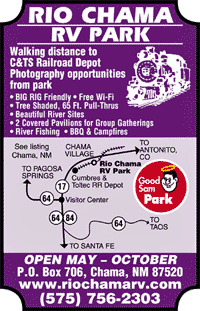
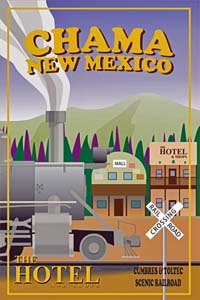
13 Aug 2015 - A Lofty Ride on the C&TS
30 Jul 2017 - Remote School Teaches People How to Drive a Steam Engine
12 Jan 2018 - C&TS Has Strong Year
18 Aug 2018 - C&TS Steams Through Fall Scenery
26 Jan 2019 - New Film About C&TS Released
12 Jun 2019 - C&TS Honored by USA Today
14 Jun 2019 - C&TS Rotary Snowplow OY Takes an Important Trip
20 Jun 2019 - 64 Miles of Rocky Mountain Splendor
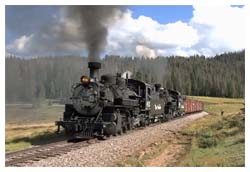 To commemorate the 50th anniversary of the last Rio Grande revenue freight over Cumbres Pass, Trains Magazine sponsored a 2 day charter on the Cumbres & Toltec Scenic Railroad. The first day featured K-36 number 483 (488 in disguise) and number 484 on a freight from Chama to Cumbres.
To commemorate the 50th anniversary of the last Rio Grande revenue freight over Cumbres Pass, Trains Magazine sponsored a 2 day charter on the Cumbres & Toltec Scenic Railroad. The first day featured K-36 number 483 (488 in disguise) and number 484 on a freight from Chama to Cumbres.
Cumbres & Toltec Scenic Railroad
Friends of the Cumbres & Toltec Scenic Railroad
The Narrow Gauge Circle (Link fails 11 May 2022)
D&RGW Narrow Gauge Steam Locomotive Photos
Wikipedia - William Jackson Palmer
Wikipedia - San Juan Mountains
 Rotary Snowplows on the Cumbres & Toltec Scenic RailroadHereford, Joseph P.1998University of New Mexico.Paperback72 pages, 11.2 x 8.8 inches, US$9.98 (Amazon)Winter in the mountains always poses a special challenge to trains,deep snow drifts, over ten feet high, make the track impassible. To remove snow blockades, the rotary snowplow was developed in the late 1880s. This wheel, over nine feet in diameter, cuts into the snow and throws it away from the track. Since it was formed in 1970, the Cumbres & Toltec Scenic Railroad has on six occasions used the rotary snowplow to clear its track of accumulated snow over the 10,015 foot Cumbres Pass. It has also been used for a few public demonstrations and in filming commercials. This book is a complete photographic record of all these modern uses of the rotary snowplow. The accompanying text is a detailed history of its development and operation, which entails close coordination between crew and equipment.
Rotary Snowplows on the Cumbres & Toltec Scenic RailroadHereford, Joseph P.1998University of New Mexico.Paperback72 pages, 11.2 x 8.8 inches, US$9.98 (Amazon)Winter in the mountains always poses a special challenge to trains,deep snow drifts, over ten feet high, make the track impassible. To remove snow blockades, the rotary snowplow was developed in the late 1880s. This wheel, over nine feet in diameter, cuts into the snow and throws it away from the track. Since it was formed in 1970, the Cumbres & Toltec Scenic Railroad has on six occasions used the rotary snowplow to clear its track of accumulated snow over the 10,015 foot Cumbres Pass. It has also been used for a few public demonstrations and in filming commercials. This book is a complete photographic record of all these modern uses of the rotary snowplow. The accompanying text is a detailed history of its development and operation, which entails close coordination between crew and equipment. Thunder of Their Passing, TheRobert D. Turner.2003Sono Nis Press.Hardcover288 pages, 11.1 x 9.2 inches, US$56.35 (Amazon)Featuring nearly 500 outstanding color and black and white photographs, illustrations, and reproductions. Complete with detailed text, bibliography, and index. Robert Turner's beautiful and moving tribute to the Rio Grande's narrow gauge is his 14th book on western transportation history. A historian and photographer with an extensive professional background in museums, historic sites, and heritage restoration projects, he has been fascinated by the narrow gauge railroads of Colorado and New Mexico for more than 35 years.
Thunder of Their Passing, TheRobert D. Turner.2003Sono Nis Press.Hardcover288 pages, 11.1 x 9.2 inches, US$56.35 (Amazon)Featuring nearly 500 outstanding color and black and white photographs, illustrations, and reproductions. Complete with detailed text, bibliography, and index. Robert Turner's beautiful and moving tribute to the Rio Grande's narrow gauge is his 14th book on western transportation history. A historian and photographer with an extensive professional background in museums, historic sites, and heritage restoration projects, he has been fascinated by the narrow gauge railroads of Colorado and New Mexico for more than 35 years. Ticket to ToltecOsterwald, Doris B.2005Golden Bell Press.Paperback? pages, 8.2 x 10.8 inches, US$62.18 (Amazon)You can get a much better appreciation of the work it took to build this branch line. Good book for any railroader. Excellent description of this railroad, it's route, and it's history.
Ticket to ToltecOsterwald, Doris B.2005Golden Bell Press.Paperback? pages, 8.2 x 10.8 inches, US$62.18 (Amazon)You can get a much better appreciation of the work it took to build this branch line. Good book for any railroader. Excellent description of this railroad, it's route, and it's history. Cumbres & Toltec: A Photographic Tribute to America's Most Spectacular Scenic RailwayFurukawa, Sam2007Narrow Gauge Preservation Society.Hardcover176 pages, 11.3 x 8.6 inches, US$35.84 (Amazon)Cloth with dust jacket in full color. Almost hidden from public view in a high and remote corner of the Rocky mountains is the Cumbres & Toltec Scenic Railroad. This line passes through some of the most spectacular mountain scenery anywhere in the world. If that weren't distinction enough, trains on the C&TS are powered by steam locomotives. The trains they pull, and the scenery they run through, are the subjects of the photographs in this book. The history of the line has been covered in dozens of books. Instead of more history, this volume seeks to show what the C&TS looks like today. While you'll find plenty of photos of locomotives and trains, you'll also find pictures made to evoke the vastness of the scenery that surrounds them. If you are among the hundreds of thousands of visitors that have ridden C&TS trains, the photos in this book are what your experience looked like from trackside. Some of the pictures are from well beyond trackside, including a series of remarkable photos shot from a jet helicopter at the height of the fall foliage season in the San Juan mountains. Featuring 237 dramatic photos of America's premier narrow gauge living history museum, this book is the result of Sam Furukawa's longtime fascination with the C&TS.
Cumbres & Toltec: A Photographic Tribute to America's Most Spectacular Scenic RailwayFurukawa, Sam2007Narrow Gauge Preservation Society.Hardcover176 pages, 11.3 x 8.6 inches, US$35.84 (Amazon)Cloth with dust jacket in full color. Almost hidden from public view in a high and remote corner of the Rocky mountains is the Cumbres & Toltec Scenic Railroad. This line passes through some of the most spectacular mountain scenery anywhere in the world. If that weren't distinction enough, trains on the C&TS are powered by steam locomotives. The trains they pull, and the scenery they run through, are the subjects of the photographs in this book. The history of the line has been covered in dozens of books. Instead of more history, this volume seeks to show what the C&TS looks like today. While you'll find plenty of photos of locomotives and trains, you'll also find pictures made to evoke the vastness of the scenery that surrounds them. If you are among the hundreds of thousands of visitors that have ridden C&TS trains, the photos in this book are what your experience looked like from trackside. Some of the pictures are from well beyond trackside, including a series of remarkable photos shot from a jet helicopter at the height of the fall foliage season in the San Juan mountains. Featuring 237 dramatic photos of America's premier narrow gauge living history museum, this book is the result of Sam Furukawa's longtime fascination with the C&TS. Saving the Cumbres & Toltec Scenic RailroadWilson, Spencer2012The History Press.Hardcover192 pages, 6 x 9 inches, US$26.84 (Amazon)The Cumbres & Toltec Scenic Railroad has operated for more than three decades as a tourist ride over the breathtaking Cumbres Pass, ten thousand feet above sea level in the Rocky Mountains. The sixty-four miles of the former San Juan Extension of the Denver & Rio Grande Western Railway were saved twice by volunteers from the railroad graveyard. In 1970, the States of Colorado and New Mexico bought the railroad. New Mexico historian and C&TS commissioner and spokesman Spencer Wilson offers an insider's account of this triumphant tale of historical preservationists succeeding on an impressive scale.
Saving the Cumbres & Toltec Scenic RailroadWilson, Spencer2012The History Press.Hardcover192 pages, 6 x 9 inches, US$26.84 (Amazon)The Cumbres & Toltec Scenic Railroad has operated for more than three decades as a tourist ride over the breathtaking Cumbres Pass, ten thousand feet above sea level in the Rocky Mountains. The sixty-four miles of the former San Juan Extension of the Denver & Rio Grande Western Railway were saved twice by volunteers from the railroad graveyard. In 1970, the States of Colorado and New Mexico bought the railroad. New Mexico historian and C&TS commissioner and spokesman Spencer Wilson offers an insider's account of this triumphant tale of historical preservationists succeeding on an impressive scale.




